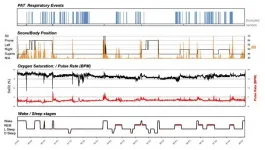Researchers find a way to mend a broken heart
2021-04-20
(Press-News.org) A Monash University study has uncovered for the first time a way to prevent and reverse damage caused by broken-heart syndrome, also known as Takotsubo cardiomyopathy.
Using mouse models, the pre-clinical study published in the acclaimed journal Signal Transduction and Targeted Therapy, has shown the cardioprotective benefit of a drug called Suberanilohydroxamic acid, or SAHA, dramatically improved cardiac health and reversed the broken-heart. The landmark study used SAHA to target genes and is a world first for Takotsubo cardiomyopathy.
SAHA, currently used for cancer treatment, is approved by the US Food and Drug Administration (FDA) and Australian Therapeutic Goods Administration (TGA), works by providing a protective benefit to genes and in particular the acetylation/deacetylation (Ac/Dc) index, an important process that regulates gene expression.
The goal of the study, led by Professor Sam El-Osta from Monash Central Clinical School, was to better understand the regulatory mechanism as a first step towards improved treatment plans.
"We show for the first time a drug that shows preventative and therapeutic benefit is important to a healthy heart. The drug not only slows cardiac injury, but also reverses, the damage caused to the stressed heart," Professor El-Osta said.
Broken-heart syndrome is a weakening of the left ventricle, the heart's main pumping chamber and is brought on by stressful emotional triggers often following traumatic events such as the death of a loved one or a family separation. This condition mimics a heart attack with chest pain, shortness of breath and irregular heartbeat.
In western countries there is a clear, uneven distribution among patients with Takotsubo - the condition occurs almost exclusively in women, especially after menopause, with new research suggesting that up to 8 per cent of women suspected of having a heart attack may have this disorder.
While the main symptoms are chest pain and shortness of breath, the precise cause isn't known. Experts think that surging stress hormones essentially flood the heart, triggering changes in heart muscle cells or coronary blood vessels (or both) that prevent the left ventricle from contracting effectively. This causes the heavy-achy-feeling you get in the chest which can be mistaken as a heart attack.
Most patients recover fully within two months which is the good news, but the bad news is that along the way some patients suffer from significant heart failure and other in-hospital complications. There is no standard treatment for broken-heart and while death is rare, heart failure occurs in about 20 per cent of patients, with therapeutic options remaining limited.
"This pre-clinical study describes a new standard in preventative and therapeutic potential using a cardioprotective drug that targets genes in the heart," Professor El-Osta said.
The team is committed to the research of women's health recognising the uneven sex prevalence of almost 9:1 (female to male). Based on these promising results we are focussed on the continued development of compounds like SAHA to improve cardiac benefit and healthier life."
INFORMATION:
Read the full paper published in Signal Transduction and Targeted Therapy titled: SAHA Attenuates Takosubo-like Myocardial Injury by Targeting an Epigenetic Ac/Dc Axis.
DOI: 10.1038/s41392-021-00546-y
For Media Enquiries please contact:
E: wendy.smith1@monash.edu
T: +61 (0) 425 725 836
For more Monash media stories, visit our news and events site
ELSE PRESS RELEASES FROM THIS DATE:
2021-04-20
For the first time, a study has shown a clear link between the frequency and duration of unconscious wakefulness during night-time sleep and an increased risk of dying from diseases of the heart and blood vessels, and death from any cause, particularly in women.
The study of 8001 men and women, which is published today (Tuesday) in the European Heart Journal [1], found that women who experienced unconscious wakefulness most often and for longer periods of time had nearly double the risk of dying from cardiovascular disease during an average of between 6 and 11 years' ...
2021-04-20
Taking multivitamins, omega-3, probiotics or vitamin D supplements may lessen the risk of testing positive for SARS-CoV-2, the virus responsible for COVID-19 infection--at least among women--indicates a large population study, published online in the journal BMJ Nutrition Prevention & Health.
But taking any of vitamin C, zinc, or garlic supplements wasn't associated with a lower risk of testing positive for the virus, the findings show.
There has been plenty of celebrity endorsement of the use of dietary supplements to both ward off and treat COVID-19 infection since the start of the pandemic, note the researchers.
In the UK alone, market share ...
2021-04-19
Nanochannels have important applications in biomedicine, sensing, and many other fields. Though engineers working in the field of nanotechnology have been fabricating these tiny, tube-like structures for years, much remains unknown about their properties and behavior.
Now, University of Maryland mechanical engineering associate professor Siddhartha Das and a group of his Ph.D. students have published surprising new findings in the journal ACS Nano. Using atomic-level simulations, Das and his team were able to demonstrate that charge properties as well as charge-induced fluid flow within a functionalized nanochannel does not always behave as expected.
"We've discovered a new context for nanochannels functionalized by grafting ...
2021-04-19
One of the marks of a successful idea in science is how quickly it can develop and evolve. In the case of the Anthropocene, the conceptual evolution has taken place with extraordinary speed. The strikingly influential hypothesis launched by the late Nobel laureate Paul Crutzen (Obituary, 24th Feb 2021) in 2000, was that the actions of an industrialised humanity has impacted the Earth so greatly as to trigger a new geological epoch. Originally developed within the Earth System science community in charting global environmental change, the Anthropocene then began ...
2021-04-19
April 19, 2021 -- Ensuring COVID-19 vaccine access for refugee and displaced populations, and addressing health inequities, is vital for an effective pandemic response. Yet, vaccine allocation and distribution has been neither equitable nor inclusive, despite that global leaders have stressed this as a critical aspect to globally overcoming the pandemic, according to a paper published by Columbia University Mailman School of Public Health. Read "Leave No-one Behind: Ensuring Access to COVID-19 vaccines for Refugee and Displaced Populations" in the journal Nature Medicine.
As of April 1st, high and upper-middle-income countries received 86 percent of the vaccine doses delivered worldwide, while ...
2021-04-19
Tools that allow neuroscientists to record and quantify functional activity within the living brain are in great demand. Traditionally, researchers have used techniques such as functional magnetic resonance imaging, but this method cannot record neural activity with high spatial resolution or in moving subjects. In recent years, a technology called optogenetics has shown considerable success in recording neural activity from animals in real time with single neuron resolution. Optogenetic tools use light to control neurons and record signals in tissues that are genetically modified ...
2021-04-19
A group of scientists have just made a key discovery that could prevent and eradicate immune responses that lead to treatment failure in about one-third of people with severe hemophilia A.
Hemophilia is the most common severe inherited bleeding disorder in men. The disease affects 1 in 10,000 males worldwide and results from deficiency of blood clotting factor VIII (FVIII). Both children and adults with hemophilia A (80 percent of all hemophilia) receive treatment that involves infusing FVIII protein into the bloodstream. However, about 30 percent ...
2021-04-19
Our planet's worst mass extinction event happened 252 million years ago when massive volcanic eruptions caused catastrophic climate change. The vast majority of animal species went extinct, and when the dust settled, the planet entered the early days of the Age of Dinosaurs. Scientists are still learning about the patterns of which animals went extinct and which ones survived, and why. In a new study in PNAS, researchers found that while extinctions happened rapidly in the oceans, life on land underwent a longer, more drawn-out period of extinctions.
"People assumed that because the marine extinction happened over a short period of time, life on land should have followed the same pattern, but we found that the marine extinction ...
2021-04-19
Professor Nicole Boivin, Director of the Department of Archaeology at the Max Planck Institute for the Science of Human History in Jena, Germany, is part of an international initiative to examine the implications of past land use for contemporary conservation efforts.
The multi-disciplinary team, which includes archaeologists, ecologists, anthropologists and conservation managers, has reconstructed ancient population and land use to show that already by 12,000 years ago, humans had re-shaped much of the terrestrial biosphere.
Their data challenge the idea that conservation ...
2021-04-19
New research published today in the Proceedings of the National Academy of Sciences (PNAS) shows that land use by human societies has reshaped ecology across most of Earth's land for at least 12,000 years. The research team, from over ten institutions around the world, revealed that the main cause of the current biodiversity crisis is not human destruction of uninhabited wildlands, but rather the appropriation, colonization, and intensified use of lands previously managed sustainably.
The new data overturn earlier reconstructions of global land use history, some of which indicated that most of Earth's land was uninhabited even as recently as 1500 CE. Further, ...
LAST 30 PRESS RELEASES:
[Press-News.org] Researchers find a way to mend a broken heart




